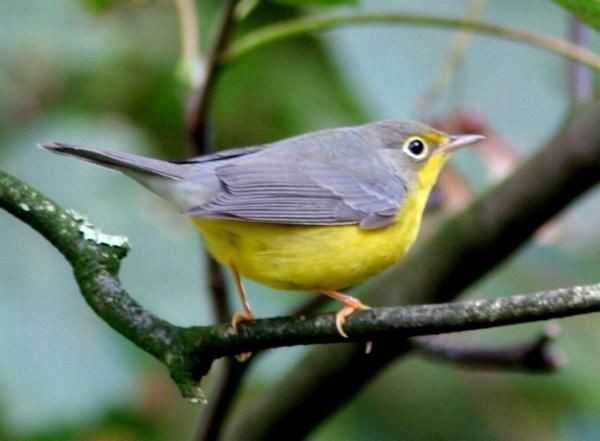
Canada Warbler, Kilbaha, Co Clare (Michael O'Keefe).
On Saturday 7 October, at 2 am, I set off with Owen Foley on the longest journey to see a bird I've been on since coming to Ireland five years ago. A long-staying Snowy Owl (and a recently arrived Red-eyed Vireo) on The Mullet, County Mayo, north-west Ireland, had enticed me into the kind of overnight six-hour journey that used to be bread and butter for me in my British twitching period from 1984-1993. Snowy Owl is a bird I hadn't seen since a young male on Shetland brought up the 350th bird on my life list some 20 years ago. Despite their occasional appearance in New Jersey, USA, I hadn't managed to see one in my five winters over there, and I felt it was time I arranged to see another individual of this truly outstanding species.
We got to Blacksod, Belmullet, home of former Shetland birder Dave Suddaby, for soon after first light, and easily found the location to begin looking for the owl. The bird itself proved harder to find. There was a stark bleakness to the landscape of this part of the world, augmented by a wind of breathtaking velocity and a series of mighty squalls, which soon had us stumbling back to the car in a great hurry. I opened the passenger door to step inside and the wind whipped it shut with such force that I hadn't time to get out of the way before it crashed into the side of my face, cutting an inch-long wound across my eyebrow that had me mopping up blood for fully 20 minutes. Owen declined to go outdoors a second time, so we set off instead in search of the Red-eyed Vireo that had been around for two days.
Against my expectations, in the face of such a wind, we not only managed to get a view of the vireo after an hour's patient waiting, we saw it quite well: low down in a sheltered corner of Escallonia. Unlike Snowy Owl, Red-eyed Vireo is a bird with which I am comfortably familiar. But after a gap of five years since the hundreds I encountered in Cape May, it was a beauty to see with its lime-green upperparts, silky-white belly and head pattern of blue, white and black. Since it was only a week since I refreshed myself with a re-read of Richard Millington's 1980 classic Twitcher's Diary, I smiled as I remembered his description of the Red-eyed Vireo he saw on Scilly as a 'totally hyperzonky megacrippler!' Indeed, with its robust build and ebullient nature (as well as its plumage coloration) it's easy to imagine why this is still a perennially popular transatlantic visitor no matter how many dozens have gone on to reach European shores since then. How different, I reflected, was the context between seeing them in my garden in America and seeing one here: a wind-blown stray sentenced to a 3,000-mile journey across the Atlantic and forced to seek shelter in the scantest of cover. It was a gratifying moment to be watching it.
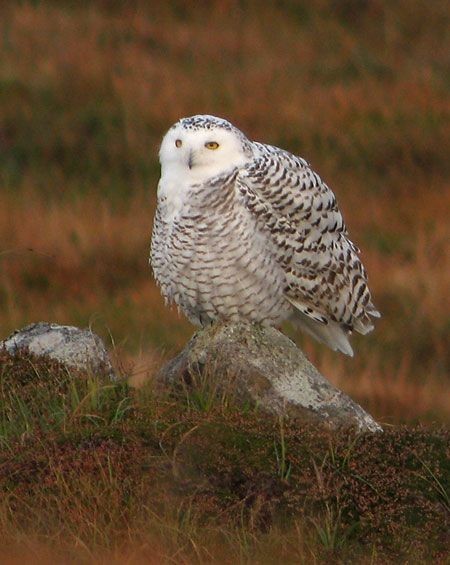
Snowy Owl, Blacksod, Co Mayo (Steve Blain).
And, in a very different way, so was the Snowy Owl. We got to see the owl the second time we looked, though it was looking a little uncertain for half an hour. I eventually located it in my telescope in the distance, looking far, far, more Dulux-white than my temporary hallucinations with quite similarly-shaped (but ultimately much too insipidly grey) lumps of rock had suggested. It was a magnificently impressive creature – as you no doubt can judge from a number of the super portraits of it that have appeared on the internet in the past weeks. We crept closer to it, not especially close as it was looking at us quite warily, but close enough to see its big, characterful, yellow eyes. After 30 minutes of sitting and swivelling its massive head (heavily flecked black on the nape offsetting a huge bald spot!) it finally took flight for a short distance, eliciting renewed murmurs of approval from the ten birders watching it. It looked like a ghostly apparition flying across the barren escarpment; the wings seeming to bulge out at the primaries, adding to its size.
Around midday we added a nearby Lesser Yellowlegs to the morning's show, though by now a wretched drenching rain had set in, making birding none too pleasant an activity. We checked out a number of interesting local wader spots from the car for the remainder of the day, occasionally braving the relentless wind and rain for a minute's perusal of a likely-looking garden. But to tell the truth, I wasn't too keen to be trespassing on another birder's local 'patch'. As I indicated earlier, in my five years in Ireland this was the first time I'd really gone off long-distance chasing other people's birds and I was in the mood to indulge it. It was a conscious decision I'd come to earlier in the autumn. To complement the countless hours I spent on my own at Ballycotton and the Old Head of Kinsale it was time I took up the occasional offers I receive to get out and travel around the country to see some great birds.
I mention this as background to what would happen the next day ...
Sunday morning was slightly more pleasant than Saturday had been but there was still that frustrating wind. After checking out of our bed and breakfast in the town of Belmullet, we drifted somewhat listlessly around a few spots before gradually beginning the long journey back. We saw little of note. I kept my eye on the landscape as we wound our way back through Co Mayo, enjoying its well-kept little towns, but noting again that bleakness in-between that would put me off living here no matter how good the birds I'd just seen. I looked forward to our return to the variety and splendour of the landscape of my adopted Co Cork.
A last stop at the Shannon Airport lagoons on the way back south added nothing to the weekend but an apparent closure to proceedings.
Thirty minutes later, just as we were about to broach the traffic in Limerick city centre, my text alert rang: "Maurice Hanifan has just found what appears to be a Canada Warbler at Kilbaha!"
Driver Owen Foley wasted no time whatsoever. Instead of taking the second exit south off the roundabout we were approaching, we took the fourth exit north, back in the direction we had just come from. Owen's quick mind, familiar with the route from his numerous visits to the Bridges of Ross in the summer, calculated we could get there in an hour and 20 minutes with maybe half an hour to spare before dark! Considering the sky was already looking gloomy, there was nothing more than an outside chance we'd make it there in time.
Having just given notice of my initiation back into to the twitching fold 48 hours earlier, it really didn't get much better than this! A bird new to Britain and Ireland, a fantastic-looking American, and we were as perfectly placed to see it as fate could have arranged! Details of the sighting were sketchy at first, but within 20 minutes we had an on-site report. Seamus Enright, Maurice's best mate, was there with him watching it, and he'd taken over the responsibility of phoning out the news because the finder himself had become literally speechless with amazement.
Well, you would be wouldn't you...?
The Sunday afternoon traffic threw up a few minor obstacles to our progress, but once out on the last 50-km stretch from Ennis to Loop Head a heartening sight was to greet us. We were surrounded on three sides by low brooding grey cloud, but there in front of us, in the direction we were heading, was a beautiful strip of clear blue. The sun's rays beaming down through the thin white cloud above like some celestial guiding light. "Over here," it seemed to suggest. "Just come right this way."
With one emergency stop, for me to relieve myself of the litre of water I'd consumed en route, we bowled up in Kilbaha at exactly 6.30 pm.
I was amazed to find Maurice and Seamus stood there by themselves. No-one else had made it. They were standing in hushed reverence. The sun that had broken through for the last half-hour of the journey had now disappeared. There might be an hour of light left but not much of it would be decent. It was still and silent, in marked contrast to the rushing wind of the previous 36 hours.
We hadn't waited long at all when a small bird flew across the road in front of us, landing low down in the sycamore tree in which the two lads had first found it. Owen and I lifted our binoculars simultaneously and got onto the bird at the exact same time. My view was partially obscured, as the bird flitted rather more restlessly through the foliage than I remembered them from Cape May, but it was a Canada Warbler alright! It flew back to dense cover and we didn't see it again that evening. Nor did anybody else, four anxious birders arriving soon after its departure for the day.
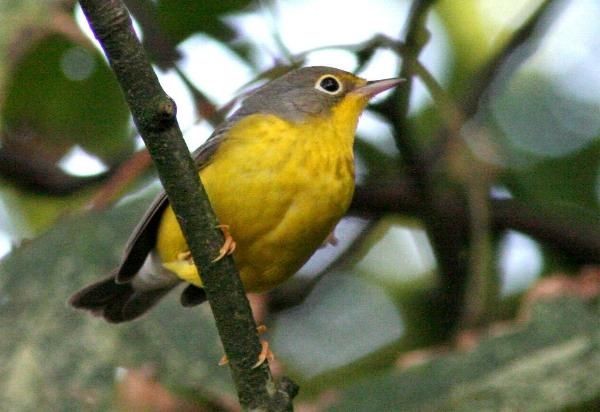
Canada Warbler, Kilbaha, Co Clare (Michael O'Keefe).
What a gripping story this would have been if that had been the last that was ever seen of the Canada Warbler! There are a number of one-day Nearctic warblers: Wilson's Warbler; Blackburnian Warbler; Chestnut-sided Warbler; and Bay-breasted Warbler came to mind. But to be honest I don't think any of the four of us really hoped it would be gone by the morning; it was too good an event for other people to miss. It did cross our minds though at frequent intervals during what was, I tell you, a very satisfying night.
And it was followed by what I have to say was a very satisfying next day ...
Monday morning dawned still and clear. Perhaps a little too early, a body of about 40 blokes gathered silently in a C-shaped huddle beneath the trees in which we expected the bird to appear.
"What's this, a candlelit mass?" said one of the relative latecomers in a soft Dublin accent.
He might not have been far wrong. But the vigil, and the silence, quickly evaporated with the first hushed shout that the bird had appeared. For the next 20 minutes a real tension seemed to take hold as those present struggled to get their first views. Newcomers kept arriving all the time. By about nine o'clock I counted 46 heads hemmed in on two sides of the road as the bird took up the performance in a different set of sunlit trees. Much of the early morning panic slowly evaporated, and began to appear totally unnecessary, as the bird popped out for brief, but satisfying, views in the crisp October sunshine.
The first Brits arrived from the overnight passenger ferry from Holyhead to Dublin including my old mate, and sparring partner, Alan Lewis, who I hadn't seen since 1993! Alan and I had been inseparable for almost 18 months in the late Eighties as we went on to compile the top British year-list of 325 in 1986 (though as he pointed out my Red-breasted Goose was knocked back as an escape!) and on our first overseas trips together to Spain and Thailand. Now 'world listing' at some 6,000 species Alan still manages, when he can, to keep up with new birds for his British and Irish list. He wasn't the only one in the same bracket. As the day progressed I went on to encounter several of my old acquaintances from the British twitching fraternity, and whilst I might have dropped out of the 'scene' myself, I was amazed to see so many of them still able to drop everything at short notice in quest of another 'domestic' tick.
And what a tick! What a bird! What an event! Part of me had longed to be the one to pull out the mega that would motivate the boys on the other side of the Irish Sea to make the journey across here, but part of me was just as pleased for Maurice for having been the one to do it. At least I was here to share it. Despite our fears from the night before that viewing would be difficult in the narrow lane, the very nature of the location (a plane hop and two hours drive from Shannon airport) meant that there were rarely more than 50 birders present at one time, and this was manageable in the circumstances. The sun shone all day and there was only the slightest suggestion of a breeze.
It was perfect.
I returned at intervals throughout the day to soak up extended views of the Canada Warbler though 'extended' is perhaps not quite the appropriate word. Sometimes there were 20 minutes to half-an-hour when it didn't appear; when it did, it showed for two or three minutes or less. But each time it popped out was a moment to savour. In my estimation, and I've seen about 100 of them in North America so it might be worth something, the bird was a first-winter female. It was, admittedly, decidedly bright yellow on the underparts, which might suggest a male. But if so it should have had some black about the face and a more clearly defined breast band. Instead, the most prominent feature of the face was the complete white eye-ring (present in males too but they would normally show blacker lores) and the crown and nape were actually quite washed-out pale grey. Surprisingly, there was just a hint of a pale-grey wing-bar, hardly different in tone from the mantle and wings but present all the same.
I spent nearly as much time as I did looking for the Canada Warbler either chatting to my old mates or stepping back to take in the scene. It was, after all, the first time I'd been to Kilbaha myself and I was mightily impressed. Some of the other Irish lads slipped away birding after their early morning views and turned up Common Rosefinch and Red-breasted Flycatcher later in the afternoon. Again though I felt I was on somebody else's 'patch' and, with the benefit of the recent Olivaceous Warbler on Cape Clear still fresh in mind, I didn't feel obliged to go off and do anything else but indulge in the 'Main Show'.
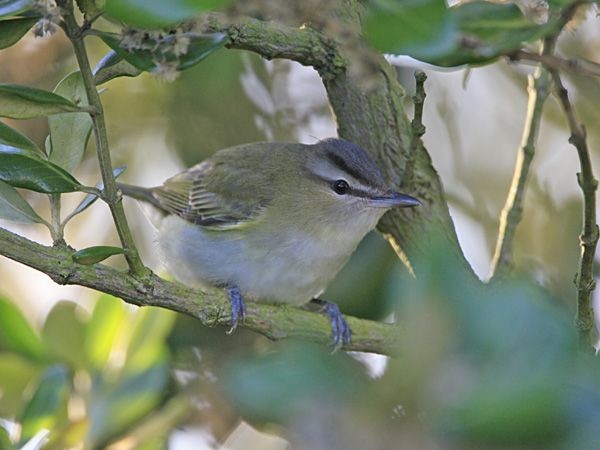
Red-eyed Vireo, Kilbaha, Co. Clare (Stuart Elsom).
The presence of a Red-eyed Vireo in the lane took some of the pressure off the Canada Warbler. This was visible either in the garden of one of the pubs, or later in a small hedge half-a-mile along the road. It showed once for me (briefly) around ten in the morning at the former location (where it had been found two days previously), down by the harbour. Late afternoon I strolled up the road to where what most people assumed was the same bird (though there has to be some doubt?) and saw it give itself up spectacularly. Here, there was only myself and five other birders present (including Steve Gantlett, Lee Evans and Steve Webb if you really need to know).
At first the bird was sitting tight in an isolated Pittosporum hedge but a little gentle pishing brought it out for a quite fantastic late evening show. By now the trees were almost rigidly still. Little swarms of tiny insects proved too much temptation for the vireo, as it lunged out 'flycatching', then sat perfectly still, with the last of the sunshine illuminating it in full view less than ten yards from us. Where earlier views might have suggested the mantle was a dull 'green-ish' now they shone back almost iridescently emerald. There was a much more intimate quality about this last sighting than my two previous encounters with the species over the weekend, and it set the seal on a fabulous couple of days.
I stayed overnight in Kilbaha with Dara Fitzpatrick and though I looked briefly next day, I saw neither the Canada Warbler nor the Red-eyed Vireo (both were still present). No, the excitement of my twitching weekend was behind me for now - it was time to get back out there and see what could be found for myself...
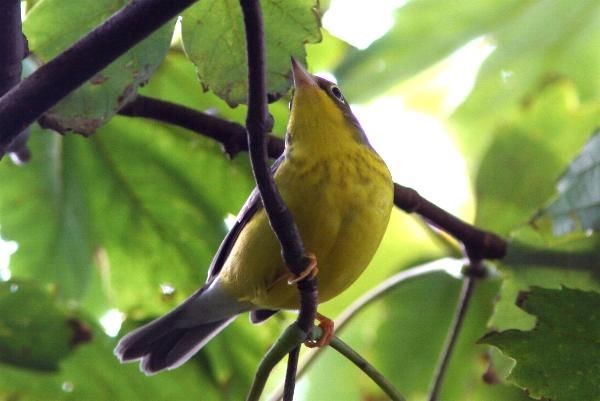
Canada Warbler, Kilbaha, Co. Clare (Michael O'Keefe).


